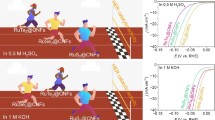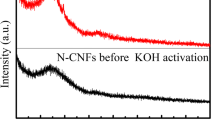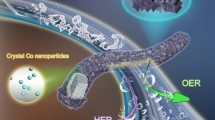Abstract
Developing highly efficient, cost-effective, and stable electrocatalysts for hydrogen evolution reaction (HER) is of considerable importance but remains challenging. Herein, we report the fabrication of a robust Ru-based electrocatalyst, which comprises heterostructured Ru-Ru2P nanoparticles that are embedded in the N,P-codoped carbon nanofibers (CNFs), through a synthetic strategy involving electrospinning and temperature-controlled pyrolysis treatment. The as-prepared Ru-Ru2P catalyst (Ru-Ru2P@CNFs) shows excellent HER catalytic activities with low overpotentials of 11 and 14 mV in acidic and alkaline media, respectively, to achieve a current density of 10 mA cm−2, which are superior to the individual components of pure Ru and Ru2P catalysts. Density functional theory calculations demonstrate the existence of electronic coupling effect between Ru and Ru2P at the heterointerfaces, leading to a well-modulated electronic structure with optimized hydrogen adsorption strength and enhanced electrical conductivity for efficient HER electrocatalysis. In addition, the overall synthetic strategy can be generalized for the synthesis of a series of transitional metal phosphide-based nanofibers, thereby holding a remarkable capacity for various potential applications.

摘要
开发高效、低价、稳定的析氢催化剂是实现电解水制氢规模产 业化的关键, 但仍面临巨大挑战. 在本文中, 我们通过静电纺丝和控温 热处理的合成路径制备了一种高活性Ru基催化剂材料, 该催化剂由异 质结构Ru-Ru2P纳米颗粒均匀负载于N、P共掺杂碳纳米纤维构成. 所 制备的Ru-Ru2P异质催化剂表现出优异的电催化析氢活性, 在酸性和碱 性电解液中产生10 mA cm−2的催化电流密度分别仅需11和14 mV的过 电位, 其性能优于对比样品纯Ru和纯Ru2P催化剂. 密度泛函理论计算结 果表明在Ru和Ru2P的异质界面处存在电子耦合效应, 从而有效调控催 化剂界面电子结构, 优化活性位点氢吸附能并提高导电性, 实现了高效 电催化析氢. 本合成策略适用于制备一系列过渡金属磷化物纳米纤维, 因而在催化和储能等领域具有广泛的应用前景.
Similar content being viewed by others
References
Sun L, Luo Q, Dai Z, et al. Material libraries for electrocatalytic overall water splitting. Coord Chem Rev, 2021, 444: 214049
Yu ZY, Duan Y, Feng XY, et al. Clean and affordable hydrogen fuel from alkaline water splitting: Past, recent progress, and future prospects. Adv Mater, 2021, 33: 2007100
Wang YZ, Yang M, Ding YM, et al. Recent advances in complex hollow electrocatalysts for water splitting. Adv Funct Mater, 2022, 32: 2108681
Wang M, Zhang L, He Y, et al. Recent advances in transition-metal-sulfide-based bifunctional electrocatalysts for overall water splitting. J Mater Chem A, 2021, 9: 5320–5363
Zhang B, Zheng Y, Ma T, et al. Designing MOF nanoarchitectures for electrochemical water splitting. Adv Mater, 2021, 33: 2006042
Li Y, Sun Y, Qin Y, et al. Recent advances on water-splitting electrocatalysis mediated by noble-metal-based nanostructured materials. Adv Energy Mater, 2020, 10: 1903120
Zhu J, Hu L, Zhao P, et al. Recent advances in electrocatalytic hydrogen evolution using nanoparticles. Chem Rev, 2020, 120: 851–918
Yang Y, Yu Y, Li J, et al. Engineering ruthenium-based electrocatalysts for effective hydrogen evolution reaction. Nano-Micro Lett, 2021, 13: 160
Bae SY, Mahmood J, Jeon IY, et al. Recent advances in ruthenium-based electrocatalysts for the hydrogen evolution reaction. Nanoscale Horiz, 2020, 5: 43–56
Zheng Y, Jiao Y, Zhu Y, et al. High electrocatalytic hydrogen evolution activity of an anomalous ruthenium catalyst. J Am Chem Soc, 2016, 138: 16174–16181
Liu T, Wang S, Zhang Q, et al. Ultrasmall Ru2P nanoparticles on graphene: A highly efficient hydrogen evolution reaction electrocatalyst in both acidic and alkaline media. Chem Commun, 2018, 54: 3343–3346
Ji L, Lv C, Chen Z, et al. Nickel-based (photo)electrocatalysts for hydrogen production. Adv Mater, 2018, 30: 1705653
Li Z, Hu M, Wang P, et al. Heterojunction catalyst in electrocatalytic water splitting. Coord Chem Rev, 2021, 439: 213953
Xu Q, Zhang J, Zhang H, et al. Atomic heterointerface engineering overcomes the activity limitation of electrocatalysts and promises highly-efficient alkaline water splitting. Energy Environ Sci, 2021, 14: 5228–5259
Zhang H, Maijenburg AW, Li X, et al. Bifunctional heterostructured transition metal phosphides for efficient electrochemical water splitting. Adv Funct Mater, 2020, 30: 2003261
Liu T, Li A, Wang C, et al. Interfacial electron transfer of Ni2P-NiP2 polymorphs inducing enhanced electrochemical properties. Adv Mater, 2018, 30: 1803590
Liu C, Gong T, Zhang J, et al. Engineering Ni2P-NiSe2 heterostructure interface for highly efficient alkaline hydrogen evolution. Appl Catal B-Environ, 2020, 262: 118245
Zeng L, Sun K, Wang X, et al. Three-dimensional-networked Ni2P/Ni3S2 heteronanoflake arrays for highly enhanced electrochemical overall-water-splitting activity. Nano Energy, 2018, 51: 26–36
Ji L, Wei Y, Wu P, et al. Heterointerface engineering of Ni2P-Co2P nanoframes for efficient water splitting. Chem Mater, 2021, 33: 9165–9173
Wang G, Chen W, Chen G, et al. Trimetallic Mo-Ni-Co selenides nanorod electrocatalysts for highly-efficient and ultra-stable hydrogen evolution. Nano Energy, 2020, 71: 104637
Huang J, Wen S, Chen G, et al. Multiphase Ni-Fe-selenide nanosheets for highly-efficient and ultra-stable water electrolysis. Appl Catal B-Environ, 2020, 277: 119220
Li SH, Qi MY, Tang ZR, et al. Nanostructured metal phosphides: From controllable synthesis to sustainable catalysis. Chem Soc Rev, 2021, 50: 7539–7586
Zhang Z, Wu X, Kou Z, et al. Rational design of electrospun nanofiber-typed electrocatalysts for water splitting: A review. Chem Eng J, 2022, 428: 131133
Wang J, Li X, Zhang T, et al. Electro-reforming polyethylene terephthalate plastic to Co-produce valued chemicals and green hydrogen. J Phys Chem Lett, 2022, 13: 622–627
Lu X, Li M, Wang H, et al. Advanced electrospun nanomaterials for highly efficient electrocatalysis. Inorg Chem Front, 2019, 6: 3012–3040
Zhang CL, Yu SH. Nanoparticles meet electrospinning: Recent advances and future prospects. Chem Soc Rev, 2014, 43: 4423–4448
Noerskov JK, Bligaard T, Logadottir A, et al. Trends in the exchange current for hydrogen evolution.. ChemInform, 2005, 36
Chi XY, Xia BG, Xu ZL, et al. Impact of cross-linked chitosan sublayer structure on the performance of TFC FO PAN nanofiber membranes. ACS Omega, 2018, 3: 13009–13019
Zhang M, Chen R, Liu X, et al. Anticorrosion study of phytic acid ligand binding with exceptional self-sealing functionality. J Alloys Compd, 2020, 818: 152875
Chen YY, Zhang Y, Jiang WJ, et al. Pomegranate-like N,P-doped Mo2C@C nanospheres as highly active electrocatalysts for alkaline hydrogen evolution. ACS Nano, 2016, 10: 8851–8860
Zhao R, Liu C, Zhang X, et al. An ultrasmall Ru2P nanoparticles-reduced graphene oxide hybrid: An efficient electrocatalyst for NH3 synthesis under ambient conditions. J Mater Chem A, 2020, 8: 77–81
Ji L, Zheng H, Wei Y, et al. Temperature-controlled fabrication of CoFe-based nanoframes for efficient oxygen evolution. Sci China Mater, 2022, 65: 431–441
Song W, Teng X, Liu Y, et al. Rational construction of self-supported triangle-like MOF-derived hollow (Ni,Co)Se2 arrays for electrocatalysis and supercapacitors. Nanoscale, 2019, 11: 6401–6409
Acknowledgements
This work was financially supported by the Natural Science Foundation of Zhejiang Province (LQ20B030001 and LY20E020002) and China Postdoctoral Science Foundation (2021M702305).
Author information
Authors and Affiliations
Contributions
Wei Y conducted the experiment and wrote the paper. Xu G conducted the DFT calculations and analyzed the data; Wei Y and Wang T did some characterizations; Ji L, Liu Z, and Wang S supervised this study and revised the paper. All authors contributed to the general discussion.
Corresponding authors
Additional information
Conflict of interest
The authors declare that they have no conflict of interest.
Supplementary information
Supporting data are available in the online version of the paper.
Yue Wei received her BSc degree from Hubei Engineering University in 2019. She is currently an MSc degree student under the supervision of Prof. Sheng Wang and Dr. Lvlv Ji at Zhejiang Sci-Tech University. Her research interests focus on the nanofibrous materials for electrocatalytic hydrogen production.
Lvlv Ji is currently a lecturer at Zhejiang Sci-Tech University. He received his BSc degree from Huainan Normal University in 2012, MSc degree from Zhejiang University of Technology in 2015, and PhD degree from Tongji University in 2018. His research interests focus on electrocatalysis, and energy storage and conversion.
Zhun Liu received his PhD degree from Beijing University of Technology in 2017. He worked as an assistant researcher at Jilin University from 2017 to 2019, and then worked at the South China Normal University from 2019 to 2021. He joined the Department of Physics, Shaoxing University in 2021. His research interests focus on electronic materials and their devices for energy conversion, information functional materials, and computational materials science.
Sheng Wang received his PhD degree from Fukui University, Japan in 2003, and then worked as assistant lecturer at Hokkaido University for three years. He joined Zhejiang Sci-Tech University in 2006 and was promoted to a full professor in 2013. His research interests include nano photocatalysis, bio-inspired strategies for functional nanomaterials, and micro/nano fibrous composites.
Supporting Information
40843_2022_2001_MOESM1_ESM.pdf
Temperature-controlled synthesis of heterostructured Ru-Ru2P nanoparticles embedded in carbon nanofibers for highly efficient hydrogen production
Rights and permissions
About this article
Cite this article
Wei, Y., Xu, G., Wei, Y. et al. Temperature-controlled synthesis of heterostructured Ru-Ru2P nanoparticles embedded in carbon nanofibers for highly efficient hydrogen production. Sci. China Mater. 65, 2675–2684 (2022). https://doi.org/10.1007/s40843-022-2001-7
Received:
Accepted:
Published:
Issue Date:
DOI: https://doi.org/10.1007/s40843-022-2001-7




